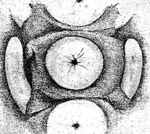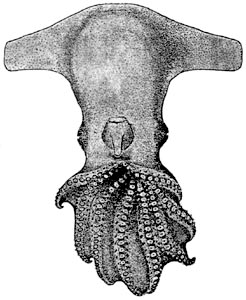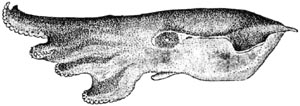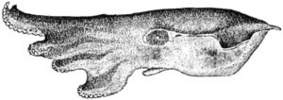Cirroctopus mawsoni
Richard E. Young and Michael VecchioneIntroduction
Cirroctopus mawsoni is the type species of the genus. It was described from a single specimen.Characteristics
- Arms and web
- Arm sucker count 27-31 [arms I-IV, holotye (O'Shea, 1999)].
- Sucker 11 of right arm I.
- Measurements
- Mantle length.....................12 mm*
- Total length......................32 mm
- Posterior mantle to base arms I...15 mm
- Mantle width......................09 mm
- Head width........................09 mm
- Width across fins.................28 mm
- Fin length........................08 mm; 12 mm*
- Fin width (midpoint)..............06.5 mm
- Funnel length.....................03.5 mm
- Length, arms I....................17 mm; 12.3*
- Length, arms II...................10.8 mm*
- Length, arms III..................10 mm*
- Length, arms IV...................10 mm*
- Web depth, sector A...............11 mm*
- Web depth, sector B...............10 mm*
- Web depth, sector C...............09.4 mm*
- Web depth, sector D...............06.6 mm*
- Web depth, sector E...............05.4 mm*
- Sucker counts, arms I.............28/28*
- Sucker counts, arms II............27/27*
- Sucker counts, arms III...........27/31*
- Sucker counts, arms IV............29/27*
- Largest arm sucker diameter.......0.6 mm*
- Largest cirri.....................0.5-1.0 mm*
- Gill lamellae.....................4?*
- Sex...............................?
* - Measurements of holotype from O'Shea, 1999. Other measurements from Berry, 1917.
 Click on an image to view larger version & data in a new window
Click on an image to view larger version & data in a new window
Figure. Oral view of left arm I and adjoining web of C. mawsoni. Drawing from Berry, 1917.
 Click on an image to view larger version & data in a new window
Click on an image to view larger version & data in a new window
Figure. Oral view of arm I sucker and adjacent cirri of C. mawsoni. Drawing from Berry, 1917.
Comments
Insufficient information exists to separate this species from G. glacialis although it has a lower arm sucker count (O'Shea, 1999) (but the holotype is smaller). If they prove to be synonymous, G. mawsoni has priority. Descriptions of animals in good condition from the type locality are needed.
This species differs from G. hochbergi in having a much lighter ventral mantle surface and a lower arm sucker count (O'Shea, 1999). Some specimens of G. glacialis, at least, also have a much lighter ventral mantle (see photos under "Pigmentation" for that species).
References
O’Shea, Steve. 1999. The Marine Fauna of New Zealand: Octopoda (Mollusca: Cephalopoda). NIWA Biodiversity Memoir 112: 280pp.
Vecchione, M., U. Piatkowski and A. L. Allcock. 1998. Biology of the cirrate octopod Grimpoteuthis glacialis (Cephalopoda; Opisthoteuthidae) in the South Shetland Islands, Antarctica. S. Afr. J. Mar. Sci. 20: 421-428.
Title Illustrations

| Scientific Name | Cirroctopus mawsoni |
|---|---|
| Reference | Berry, S.S. 1917. Cephalopoda. Scientific Reports of the Australasian Antarctic Expedition 1911-1914, (series C)14(2):1-39. |
| View | Ventral |
| Type | Holotype |
About This Page

University of Hawaii, Honolulu, HI, USA

National Museum of Natural History, Washington, D. C. , USA
Page copyright © 2016 and
 Page: Tree of Life
Cirroctopus mawsoni.
Authored by
Richard E. Young and Michael Vecchione.
The TEXT of this page is licensed under the
Creative Commons Attribution-NonCommercial License - Version 3.0. Note that images and other media
featured on this page are each governed by their own license, and they may or may not be available
for reuse. Click on an image or a media link to access the media data window, which provides the
relevant licensing information. For the general terms and conditions of ToL material reuse and
redistribution, please see the Tree of Life Copyright
Policies.
Page: Tree of Life
Cirroctopus mawsoni.
Authored by
Richard E. Young and Michael Vecchione.
The TEXT of this page is licensed under the
Creative Commons Attribution-NonCommercial License - Version 3.0. Note that images and other media
featured on this page are each governed by their own license, and they may or may not be available
for reuse. Click on an image or a media link to access the media data window, which provides the
relevant licensing information. For the general terms and conditions of ToL material reuse and
redistribution, please see the Tree of Life Copyright
Policies.
- First online 13 May 2003
Citing this page:
Young, Richard E. and Michael Vecchione. 2003. Cirroctopus mawsoni. Version 13 May 2003 (under construction). http://tolweb.org/Cirroctopus_mawsoni/20111/2003.05.13 in The Tree of Life Web Project, http://tolweb.org/










 Go to quick links
Go to quick search
Go to navigation for this section of the ToL site
Go to detailed links for the ToL site
Go to quick links
Go to quick search
Go to navigation for this section of the ToL site
Go to detailed links for the ToL site